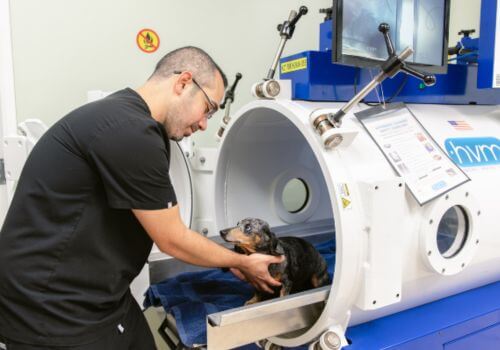Dog owners always want what’s best for their pets, especially when it comes to veterinary care and healing from injuries and medical procedures. One treatment that’s gaining traction in veterinary medicine — but still flies under the radar for many pet owners — is Hyperbaric Oxygen Therapy (HBOT).
In this blog, we’ll help you understand what hyperbaric oxygen therapy for dogs is, how it works, and when your veterinarian may recommend it as a part of your dog’s treatment plan.
The Ins and Outs of Hyperbaric Oxygen Therapy for Dogs

Although this technology has been used in veterinary medicine for decades, many pet owners aren’t familiar with hyperbaric oxygen therapy for dogs and have no idea that it can be used to heal a variety of ailments, like wounds, burns, infections, and more. Let’s break down what owners can expect when they choose treatment with an oxygen chamber for dogs.
Hyperbaric Oxygen Therapy for dogs, commonly abbreviated as HBOT, is an advanced medical treatment that utilizes high concentrations of oxygen to accelerate healing. The procedure, which is non-invasive and pain-free for animals, involves placing the dog in a specially designed hyperbaric chamber for dogs, where they will then breathe 100% oxygen at higher-than-normal atmospheric pressure.
In this environment, the high pressure is key, as it allows oxygen to dissolve more efficiently in the dog’s bloodstream – and even reach areas of the body that may typically have limited or restricted blood flow, like injured or infected limbs or tissues. This increased amount of oxygen circulating within a dog’s bloodstream can result in superior healing outcomes as the oxygen works to fight bacteria, keep swelling controlled, and promote the creation of new, healthy blood vessels.
The Safety & Efficacy of Hyperbaric Oxygen Therapy for Dogs
Hyperbaric oxygen therapy for dogs can be a game-changer for many dogs, especially those with complex or non-healing conditions. The procedure is widely considered safe and is well-tolerated by a majority of pets, with incredibly promising success rates. One study conducted by researchers at the University of Florida and Colorado State University reported that in a retrospective analysis of 2,792 HBOT sessions across various small animals – which included over 500 dogs – rates of major adverse health incidents were low. Another study focusing primarily on success rates for wound healing found that across 289 treatment sessions of cats and dogs with severe wounds, HBOT led to significant improvement in wound healing.
Curious if it might help your dog? Here are six signs that your dog could be a great candidate for HBOT.
Hyperbaric Oxygen Therapy For Dogs Is a Great Option When Your Dog Has…
1. Slow Healing or Stubborn Wounds
While every dog is bound to get a couple of cuts and scrapes throughout their lifetime, some wounds, especially those with slow or impaired healing, can pose a major threat to a dog’s health. Though slow-healing wounds don’t sound particularly dangerous, they can quickly become a problem if improperly managed – or worse, left untreated.
When it comes to open wounds on a dog’s body, one of the major concerns is the risk of infections. If a wound is left to fester or exposed to the elements, bacteria can infect the wound and eventually spread to surrounding tissue as well as other parts of the body through the bloodstream. It’s imperative that wound-related infections are not allowed to advance this far, as spread through the bloodstream can lead to life-threatening sepsis.
Even if a wound doesn’t progress to the stage of infection, the dog’s quality of life can be greatly impacted, as many wounds will cause pain or discomfort, itching or stinging, and, in some cases, changes in mood or behavior – like lethargy or irritability – due to the discomfort associated with the wound.
The good news is that many dogs with slow-healing wounds are great candidates for hyperbaric oxygen therapy, and this treatment can accelerate healing time while being used independently or alongside traditional treatment techniques like bandaging, debridement, suturing or stitching, and antibiotic usage or other therapies, like acupuncture.
HBOT is especially helpful for wounds that are:
- Deep or large
- Infected or at risk of infection
- Located on areas with poor blood flow (e.g., tail, toes, pressure points)
- Associated with underlying conditions like diabetes or Cushing’s disease
- Post-surgical and slow-to-heal
2. Neurological Trauma
Neurological injuries – like head trauma, spinal cord injury, strokes, or nerve damage – are an unfortunate reality for many dogs and their owners. When a dog’s brain, spinal cord, or nerves are damaged from an external injury or other internal condition, their body’s most critical systems are affected, which can lead to a number of undesirable side effects – from changes in personality and behavior to difficulties with basic functions, like walking, eating, and even breathing.
Because neurological issues can not only be life-threatening, but also impact a surviving dog’s long-term health and quality of life so much, they need to be managed and treated as effectively and quickly as possible to keep a dog comfortable. Oxygen is a key component in brain healing, and the highly concentrated amounts of oxygen delivered to dogs through hyperbaric oxygen therapy have shown to be a game-changer for healing outcomes when utilized after an initial injury.
Other research has shown promising results for the management of neurologic conditions as well. Increased oxygen levels from hyperbaric oxygen therapy can protect the brain from sustaining additional damage from neurological trauma and keep cognitive function from further deteriorating.
Dogs may be good candidates for HBOT if they are suffering from neurological conditions including:
- Head trauma (e.g., from a fall or car accident)
- Spinal cord injury or paralysis
- Acute disc herniation (IVDD) with neurological signs
- Stroke-like events or ischemic injury
- Cerebral edema or swelling following trauma or surgery
- Peripheral nerve injuries
Hyperbaric oxygen therapy for dogs can also be incredibly useful for managing the secondary conditions that arise as a result of neurological trauma or conditions. For example, dogs that have limited mobility as a result of head trauma or brain injury may spend more time lying down and can be more prone to developing pressure sores. These sores, also known as decubitus ulcers, develop from the constant pressure and reduced blood flow to different tissues that occurs when a dog lies in one position for too long. Pressure sores can quickly become painful and infected, making them a great use case for the enhanced healing power of HBOT.
3. Suffered from Bites, Toxins, or Smoke Inhalation
Hyperbaric oxygen therapy for dogs is an incredibly valuable tool for emergency veterinary medicine, too! Dogs who have suffered from serious animal bites, toxin exposure, or smoke inhalation are often in critical conditions and are in need of immediate medical attention. In these cases, responding early with hyperbaric oxygen therapy and dramatically increasing the amount of oxygen available in the dog’s blood, the body responds positively, with outcomes including:
- Increased Effectiveness in Tissue Repair and Infection Fighting: Bites from other animals can lead to deep puncture wounds, tissue crushing, and the introduction of harmful bacteria into a dog’s body. Opting to use the hyperbaric chamber for dogs after a bite can reduce tissue damage and enhance the dog’s immune system, helping them fight off any present infections.
- Displacement of Carbon Monoxide: Toxin exposure — such as carbon monoxide poisoning or ingestion of harmful substances — can quickly disrupt a dog’s organ function and oxygen delivery across the entire body, making increased oxygen an invaluable resource for healing. For dogs that have inhaled large amounts of smoke or are suffering from carbon monoxide poisoning, the increased oxygen from HBOT helps displace the carbon monoxide from hemoglobin in red blood cells more rapidly, allowing the body to begin healing from the inside out and minimizing damage to the lungs and brain.
4. Stubborn Infections
As we’ve discussed, infections can carry a lot of risk for our canine companions and need to be dealt with promptly by an experienced veterinarian to avoid any secondary complications or unnecessary long-term health impacts. Dogs can suffer from a number of different types of infections, ranging from more minor skin infections to deep abscesses or even osteomyelitis.
When it seems like other treatment options just aren’t working, your veterinarian may recommend hyperbaric oxygen therapy for dogs to supplement traditional infection-fighting techniques and give your dog’s immune system a much-needed boost. Research has demonstrated that HBOT can even increase the effectiveness of antibiotics, because in an oxygen-rich environment, more of the drug is able to reach infected tissue.

5. A Rocky Recovery After Surgery
Some dogs bounce back quickly after surgery, but others may struggle with complications like inflammation, poor wound healing, infection, or pain. These setbacks, while common, can significantly increase recovery times, prolonging discomfort for the dog and potentially leaving the owner stressed out, too.
Because of HBOT’s effectiveness in using high concentrations of oxygen to promote healing, it’s a great option for helping pets bounce back after surgery, especially if they have chronic conditions that impact their natural ability to heal on their own. Dogs recovering from orthopedic surgeries, soft tissue repairs, tumor removals, or skin graft procedures are often great candidates for hyperbaric oxygen therapy due to its effect on bodily tissue.
If your dog has a history of slow recovery after surgery and has another procedure coming up, talk to your veterinarian about setting up post-op HBOT sessions beforehand. That way, you can go into the procedure with more peace of mind that your dog will be on the fast track for healing and will be themself again in no time.
6. Severe Inflammation or Pain
Chronic inflammation and pain can negatively impact a dog’s overall health and happiness. Whether these chronic issues stem from an injury, an autoimmune issue, or a degenerative disease, they can lead to mobility problems, lethargy and lower activity levels, and even behavior changes, like irritability and disinterest in their favorite people, foods, toys, or activities. Tackling inflammation at the source is crucial for keeping your dog comfortable and ensuring they have a good quality of life.
Conditions that may lead to chronic pain or inflammation can all benefit from the anti-inflammatory and tissue-repairing effects of HBOT. Some common conditions include:
- Pancreatitis
- Vasculitis
- Severe allergic skin reactions
- Burns or skin sloughing
If you have questions and you'd like to reach out to us, you can call us directly at (561) 786-1100, or you can email us at customerservice@cvcboca.com. Don't forget to follow us on social media Facebook, Instagram.
